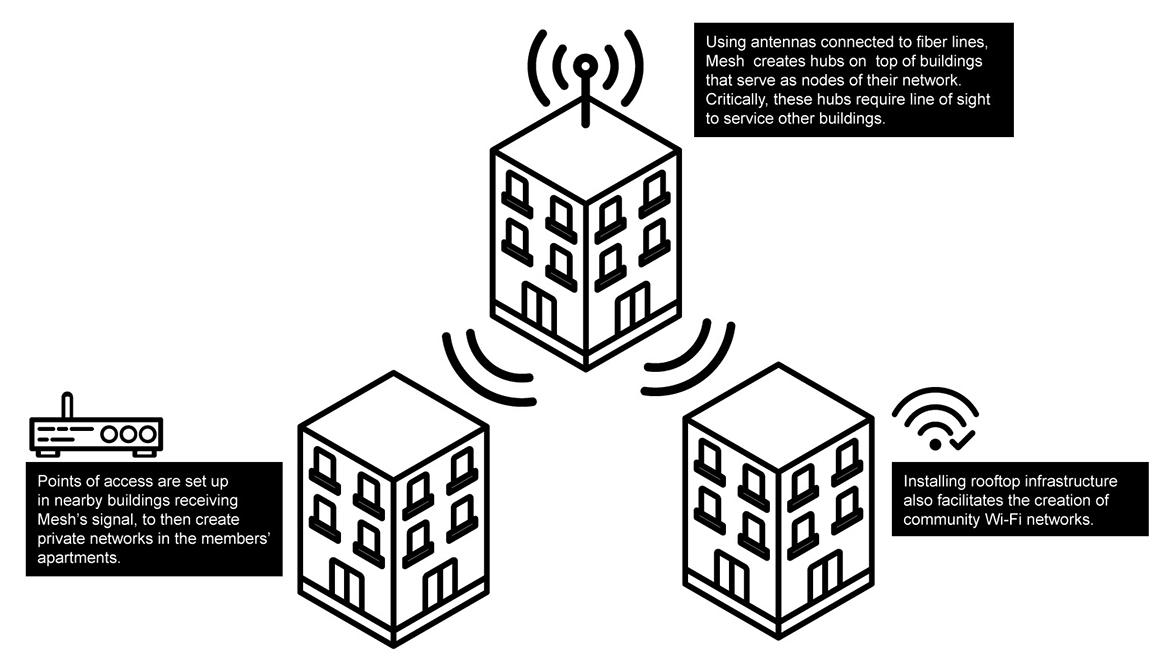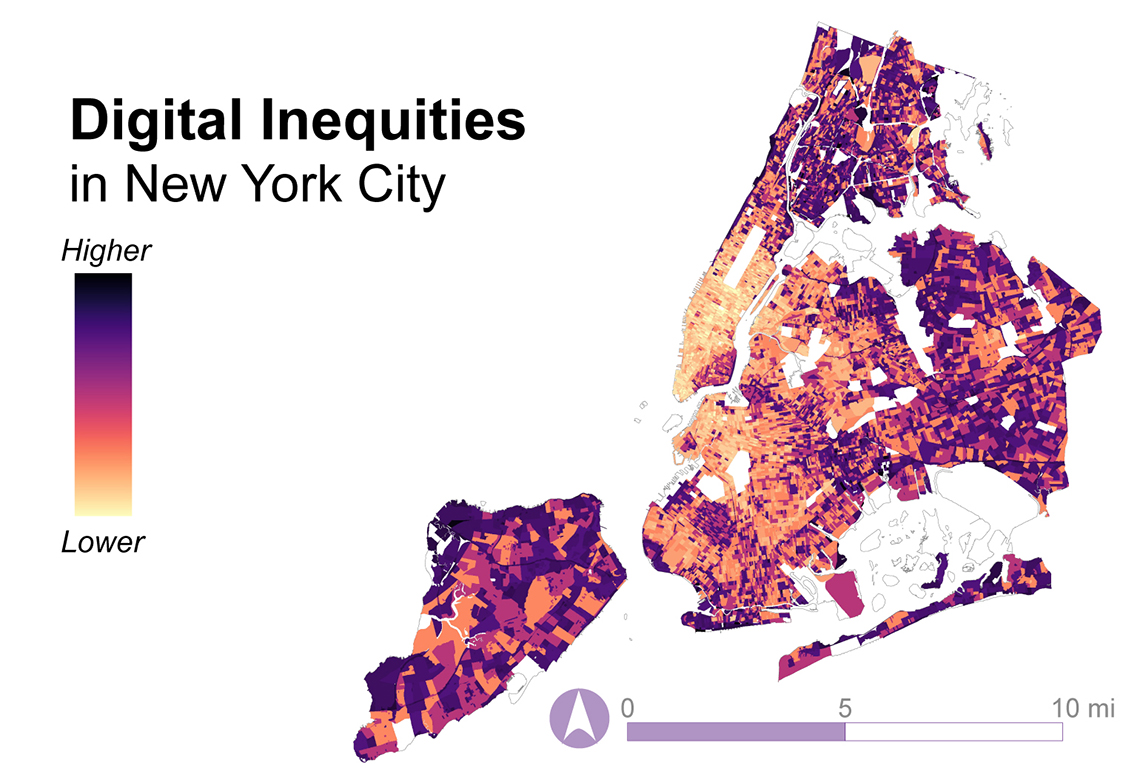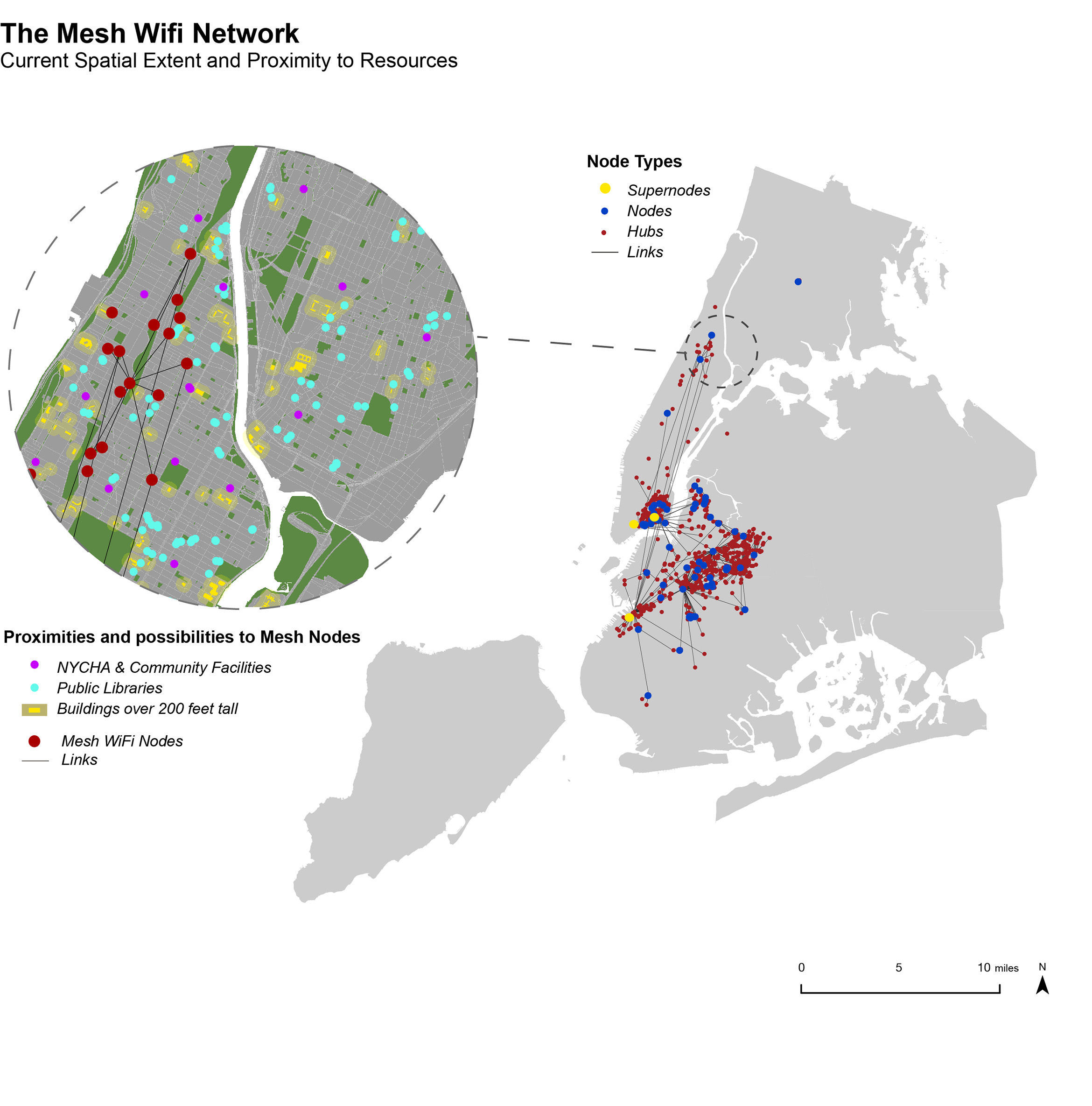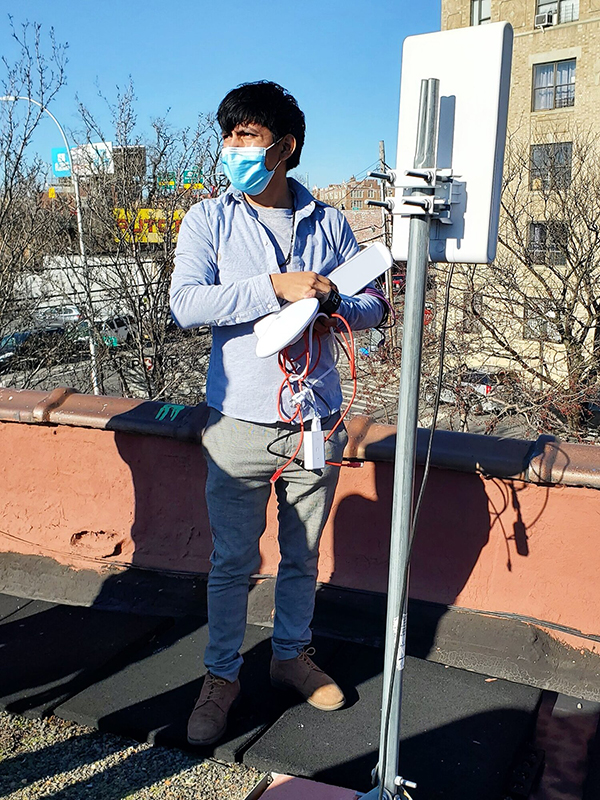
We are celebrating 15 years — and counting — of stories that are deeply researched and deeply felt, that build a historical record of what the city has been.
We are celebrating 15 years — and counting — of stories that are deeply researched and deeply felt, that build a historical record of what the city has been.
From Zoom interviews to paperless billing, everyday tasks now require a high-speed internet connection — and connectivity is critical for participating in contemporary society. But the landscape of broadband is highly unequal, one where private providers’ profits trump reliable and affordable access. The Covid-19 pandemic exposed this preexisting inequity (among so many others). Just one example: as schools pivoted to online learning, students in majority Black and Brown school districts in New York State were four times as likely to have insufficient internet service or no internet at all at home when compared to their peers in white school districts. Expanding the reach of broadband technology has a newfound centrality and urgency to infrastructural agendas. But networks that prioritize community-building and privacy over corporate interests have been growing for quite some time. Nearly a decade ago, we profiled a nascent project to develop resilient wireless infrastructure maintained by a crew of young local “digital stewards” in Red Hook, Brooklyn. More recently, we reviewed efforts to fill in the gaps where for-profit internet companies have left communities underserved across the United States. One initiative, NYC Mesh, has been growing at quite a clip to expand a local network that is affordable and democratic. Since 2018, residents have been requesting over 1,500 new nodes per year. But how can NYC Mesh expand and maintain an increasingly large footprint with an all-volunteer crew? Below, Juan Sebastián Moreno, Stefan Chavez-Norgaard, and Mia Winther-Tamaki profile the day-to-day challenges of building and maintaining community-owned internet infrastructure for all New Yorkers.
Physical internet infrastructure is on the agenda at an NYC Mesh community meeting on a Tuesday night in October 2022. Hand-written paper signs direct newcomers from Broome Street to an office where a group of about ten people, mostly young men, sit around a plastic folding table scattered with notebooks, laptops, water bottles, and off-brand potato chips. Brian Hall, a founding member, discusses the need for volunteers to set up a new network node on a Brooklyn balcony the coming weekend. Jake Hodgson, a technical production manager in events and a more recent Mesh volunteer, asks whether a rooftop at 149th Street and Amsterdam Avenue is tall enough to connect network members to Mesh’s Sugar Hill hub. After deliberation, the group agrees to try to get a bit of height by installing a mast on the site. “The Mothership,” a computer reporting the status of various Mesh nodes and “supernodes” across the city, hums from a closet of fiber cables and blinking lights. They discuss hiring a full-time staff member, brainstorm how to encourage more volunteer installations, and delve into the technical aspects of mesh software and hardware. Then Hall asks, “Are there any more questions or can we finally open the Modelos?” before passing a 24-pack around the table.
NYC Mesh is a volunteer-run, open-source, community broadband network. Since installing its first node in 2014, NYC Mesh works in service of a vision of the internet that is neighborhood-based, universally accessible, and democratic. The network is controlled and operated by and for local residents, empowering communities to take control of their internet infrastructure and services, promote digital equity, and provide a more tailored and responsive internet experience. To access the Mesh network, members mount a wireless router on a nearby rooftop or balcony and connect to other buildings, forming a network. In some cases, Mesh routers connect to fiber cables in the ground. Mesh community members pay a suggested donation to cover equipment costs and can either install required hardware on their own, or cover costs for volunteers to install relevant hardware (subsidies and sliding scales are available for those unable to afford the full cost of installation).
This network is one of numerous efforts to make broadband more equitable in New York City and the US. NYC Mesh offers an alternative to the corporate Internet Service Providers (ISPs), such as Spectrum or Verizon Fios, that dominate the market. ISPs are massive national companies that have existed for decades; they charge high prices, provide poor customer service, and offer uneven product quality. They do so because they can. ISPs gain nothing from new entrants or disruptive models in the internet service space. Moreover, many ISPs monitor digital users’ internet browsing history, often without customers’ ability to opt out of this practice, which has raised concerns about their ability to sell this customer information to advertisers or government agencies like the National Security Agency.
Broadband access is a key infrastructural project of the 21st century. President Biden often compares internet fiber expansion to rural electrification in the 1930s. The 2021 bipartisan infrastructure deal included $65 billion to invest in broadband infrastructure deployment. In New York City, Mayor de Blasio’s Internet Master Plan was a bold, aspirational effort to provide every New Yorker with affordable high-speed internet. While the Adams Administration has effectively put that plan on hold, new efforts like Big Apple Connect focus explicitly on ensuring NYCHA residents have free internet by the end of 2023. These plans all rely on traditional, for-profit ISPs.
In this moment of digital infrastructure investment, ISPs are prioritizing profits rather than the specific needs and concerns of individual communities. Practices such as data caps, service throttling, and different speeds for certain types of traffic over others can negatively impact customers’ online experiences. Whether it comes to educational resources, the ability to work remotely, entertainment, communication, or access to health and medicine, reliable internet access is more important than ever for our daily lives. Accordingly, the work of NYC Mesh can be located in a battle for what geographer Charlotte Lemanski calls “infastructural citizenship”: the idea that access to basic infrastructure is essential for individuals to participate fully in society and exercise their rights and responsibilities as citizens. Broadband represents an infrastructure of infrastructures: using Wi-Fi, low-income and vulnerable residents can organize online and push for better services for other infrastructure, too — electricity, water, sewage, classroom resources, and transparent government communications. At issue is the question of whether broadband connections — and internet service altogether — should be treated as a public utility, or even a public good.
Unequal broadband access is an equity issue: Neighborhoods of color and low-income neighborhoods in New York City have a different — more expensive, less reliable — marketplace of ISPs than do wealthier New Yorkers. On the affluent and majority-white Upper West Side of Manhattan, for instance, residents can contract their internet service with between seven and 15 ISPs, with prices and plans ranging from $45 to $115 per month for various speeds and services. Households in Edgemere, Queens, a low-income peripheral neighborhood that is majority Black, typically have access to service from one or two ISPs, companies like Optimum and Altice, with many poor customer-service reviews. Almost 32 percent of households in Edgemere have no home broadband access at all, either because service is too expensive, too unreliable, or simply unavailable.
Unfortunately, lack of transparency makes understanding broadband inequity difficult. Because all data on broadband speed and reliability are proprietary, accessing this information is immensely challenging. Information on the precise buildings served by fiber connections is triangulated and in many cases self-reported. The very lack of transparency underpinning the state of ISP service and quality speaks to the need for a more public democratic alternative.
NYC Mesh’s network is growing steadily, with between 1,500 and 3,000 new nodes requested annually, but it can only grow as fast or as sustainably as its volunteer network allows. That growth has been inconsistent partly because, in order for the network to function, there can be no objects or buildings in between rooftop nodes and home routers. Mesh’s infrastructure requires clear lines of sight, as well as technical know-how and very tangible installation skills. But it also requires a social trust that allows strangers into living rooms. To grow the system, NYC Mesh must build relationships with building owners to gain roof access, and with volunteers to build and maintain the network. The seemingly invisible world of broadband connectivity has both a physical and a social footprint.
The organization draws on a human infrastructure of social relationships to expand building-by-building, block-by-block. The community’s main form of communication takes place on a Slack messaging channel. When infrastructure goes down, committed volunteers will receive a ping, no matter what time of day or night. One volunteer, Marg Suarez, noted: “Once I got hooked into the community, I found it very welcoming. Everyone’s very technologically inclined, people are willing to walk you through to get hooked in. The other volunteers are very eager to help.”
By day, Suarez repairs elevators with Nouveau Elevator. She’s also a member of the International Brotherhood of Electrical Workers (IBEW) and works to develop curricula and trainings for new elevator-worker apprentices. She was drawn to NYC Mesh after poor experiences with the ISPs in her neighborhood of Sunset Park. “We’re in this place in New York City where you get what you get,” Suarez said. “You can try to spend hours on the phone . . . I’d been talking to customer service to get $20 off an $89.99 monthly Internet bill for hours at a time.” After hearing about the Industry City supernode in her neighborhood, Suarez decided to put her technical and teaching skills to use and help out with training and installation in 2021.
While NYC Mesh is the largest community broadband project in the five boroughs, at this time its network largely reaches areas of the city that have more infrastructural resources, ongoing investment, and have experienced gentrification. The core of the Mesh network lies in inner Brooklyn neighborhoods like Park Slope, Brooklyn Heights, Bedford-Stuyvesant, and Williamsburg. Neighborhoods like Sunset Park and the Lower East Side also have a strong NYC Mesh presence. New hubs can be found in Washington Heights and even across the Hudson River in Jersey City and Hoboken. But there is only a single node in the Bronx, and large sections of Queens and all of Staten Island have no NYC Mesh presence at all. Mesh has struggled to install new infrastructure beyond a specific type of gentrifying neighborhood: those with both significant historic populations of color and young white professionals who may have time and energy to volunteer. Mesh aspired toward service in Brooklyn’s lower-income Brownsville neighborhood but does currently not have a significant infrastructural or volunteer presence there. However, in some areas with few ISPs and a large enough network of volunteers with spare time who know about the organization, Mesh provides an alternative.
Where possible, Mesh attempts to align its nodes with tall buildings, as well as with public housing and community facilities like libraries, seeking out well-used local public spaces where community members can access services beyond Wi-Fi. Mesh has experimented successfully with infrastructure atop public housing buildings like the supernode at New York City Housing Authority’s 303 Vernon Avenue; volunteers have also met with staff of the Brooklyn Public Library on using libraries for a similar purpose. One recent Slack discussion about Bedford-Stuyvesant’s Herbert Von King Park was focused on Mesh’s ability to provide a free community Wi-Fi access point while also addressing wider community needs. NYC Mesh led a participatory public process with community members in the park to learn about the usefulness and feasibility of the project. Said one Mesh member: “We’d like to raise $1-2k to cover the Herbert Von King public Wi-Fi project, and future installs in Bed-Stuy. If we have any leftover funds after these projects are done, they’ll go towards free groceries for our neighbors.”
Mesh is not the only experiment in broadband activism in New York City. The Hunts Point Free Wi-Fi Network serves a low-income, climate-vulnerable neighborhood in the Bronx. While the initiative built five nodes around The POINT Community Development Corporation from 2018 and 2019, it has not yet expanded beyond them. In Gowanus, the 5th Avenue Committee spearheaded an open Wi-Fi “local” LinkNYC. The equity-focused organization seeks to pair broadband with affordable housing, development, and supportive-housing services. The Red Hook Wi-Fi Project remains strong but spatially limited to the Red Hook neighborhood.
These alternatives to corporate ISPs are still in an early and fragile stage. NYC Mesh runs on free labor and donations. Expanding, building, and maintaining a large network of routers and nodes is challenging in neighborhoods where residents have both less time and money to devote to Mesh. In order to sustainably expand across the city, Mesh needs to find high-skilled volunteers beyond inner Brooklyn. But Mesh’s volunteer network is actively growing within its core areas. Existing volunteers are recruiting friends, and even some high school students, teaching them how to coordinate installations. There is a role for every type of volunteer at Mesh. On Mesh’s Slack, one volunteer noted that they have technical skills but lack networking skills to pitch Mesh to neighbors and building owners in Eastern Queens. Other volunteers may not have technical skills yet but seek to learn at one of Mesh’s regular training sessions.
As networks like NYC Mesh grow, will they be able to build, maintain, and repair broadband infrastructure while relying on unpaid labor from committed volunteers? While ISP customer service centers may be cumbersome, these organizations hire paid employees who typically work during regular business hours. In certain situations, ISPs may repair broadband infrastructure more quickly or regularly than volunteer-led collectives. Slow repairs can mean the difference between attending or missing classes on Zoom, or not being able to message a loved one overseas. ISPs also typically have paid dispatchers, repair trucks, and proprietary maintenance equipment to quickly handle infrastructural problems. By contrast, Mesh volunteers may take the subway to an install or repair site after work or school. “With any group, especially an all-volunteer-driven group, there are coordination challenges,” Marg Suarez observed. “How do you vet a change? How do you deal with the fallout? There are pains. But if you look at the coverage map . . . it’s pretty amazing what we can achieve with sort of a general community agreement to work together.”
Networks like NYC Mesh can only grow so much without assistance. Assistance may mean direct financial support from the state, but also regulatory frameworks ensuring that private ISPs cannot hoard information about infrastructure quality and reliability, or monopolize access to communities. Even transparent FCC data about ISPs’ rates, speeds, and data usage would be a tremendous tool for community broadband networks. Such data could allow mesh networks to show customers that they can provide a similar, or even higher-quality service, for a fraction of the price. Assistance might also mean support from local municipalities, and even from the federal government. (While some government officials speak about the potential of community broadband networks, they are usually framed as small side projects.)
When done right, community broadband networks — especially in low-income areas poorly served by private ISPs — can offer vastly superior service, more affordable prices, and foster new forms of digital innovation. Large-scale, high-speed, and affordable broadband provision will require a quantum leap in infrastructure, regardless of how it is structured. At stake is who will benefit and who will continue to be underserved — whether this provision will foreground equity and expand residents’ access to public goods — New York City residents’ infrastructural citizenship is on the line.
The views expressed here are those of the authors only and do not reflect the position of The Architectural League of New York.




